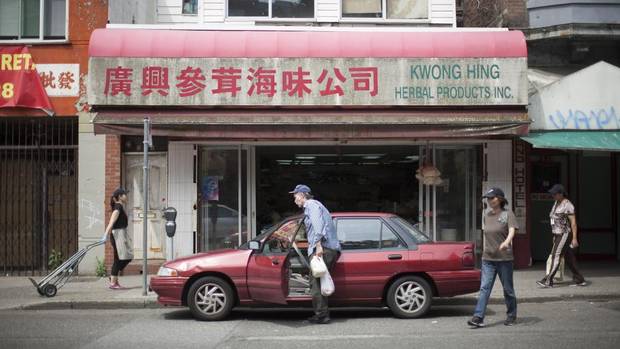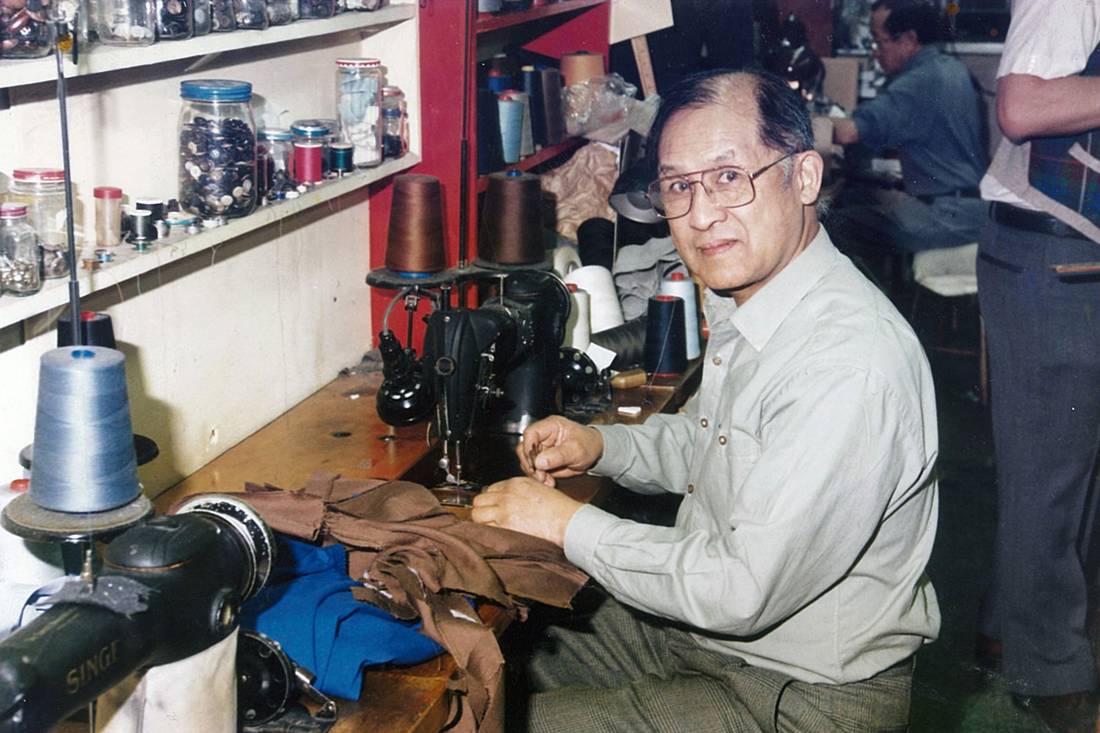Dak Molnar trekked down to Vancouver City Hall last week to talk about how important it is to keep new people and businesses coming into Chinatown.
He had made his own contribution, he said as he faced councillors in the chambers, by partnering to create a new restaurant in the neighbourhood – which, as one of the oldest Chinatowns in the country, has been designated a national historic site.
"We honoured the history of Chinatown with Sai Woo," he said, a reminder that the restaurant takes its name from a legendary noodle house that existed there decades before. The building has been painstakingly restored and the menu is a quirky, modern take on Chinese food.
Read more: A new battle to save Vancouver's Chinatown
Read more: Vancouver city planners to revisit Chinatown rezoning policy
Read more: Latest Vancouver Chinatown housing proposal headed for battle
But Mr. Molnar was booed and jeered at by the dozens of young activists, who were there to oppose the project that he came out to support: a proposed 12-storey condo building located in the heart of Chinatown, across the street from the Dr. Sun Yat-Sen garden. A few of those activists took to Twitter after to say that they now knew which neighbourhood businesses not to support.
The exchange reflects the level of animosity that has erupted in recent months as the latest condo proposal in the neighbourhood, by Beedie Development, has been transformed into a battlefield over the future of Chinatown.
The debate in Vancouver has activated a new generation of young people with Chinese heritage to storm the barricades to fight what they see as a clear-cut case of gentrification and rapacious developers endangering the history and culture of a neighbourhood that was born out of discrimination and racism.
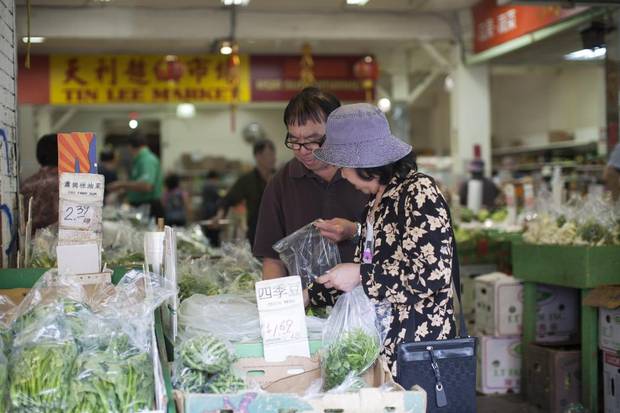
Shoppers at Tin Lee Market in Vancouver’s Chinatown.
Rafal Gerszak/for the globe and mail
Although no other Canadian Chinatown is going through quite such an extreme and polarized fight, all of them are experiencing similar tension.
Chinatowns across Canada and the United States are struggling to map out a new future, as they cope with changing demographics within the Chinese community, the rise of prosperous suburban Chinatowns, the pressures of development that undermine the character of traditional Chinatowns, and, frequently, the challenge of being in the older parts of town that are also hot spots for homelessness and drug use.
Most no longer see Chinese newcomers settling there, either because Chinatown is seen as being too close to rough parts of town or because the neighbourhood has gentrified so much in the past few decades that its housing is out of reach for new immigrants.
That has left historic Chinatowns struggling to figure out how to thrive and appeal to new customers, as traditional residents and customers have dispersed, without losing their Chineseness.
That hasn't been an easy path. Chinatowns are renowned for the multiplicity of clan associations, business groups, heritage advocates and others who all weigh in, often with contradictory solutions.
Recently, some young Chinese-Canadians, wanting to connect with the culture that their parents sometimes distanced themselves from in favour of assimilation, have appeared on the scene. That adds more energy but another complication.
"The difficulty is getting that first generation and that third generation to come together," says Terry Wong, a director of the Calgary's Chinatown business association.
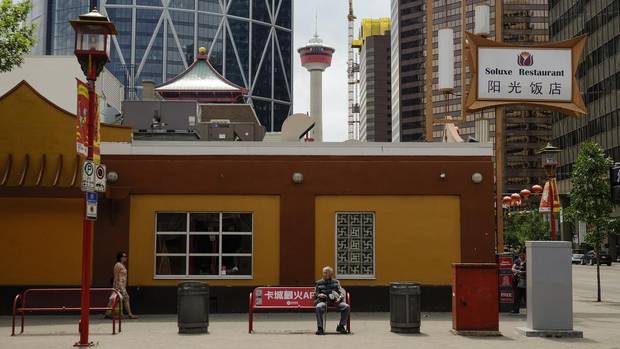
A man rests on a bench in Calgary’s Chinatown.
Jeff McIntosh/for the globe and mail
In spite of the differences, communities have mobilized to try many approaches: signs, gates, gardens and public art that visibly signal Chinese culture; walking tours and marketing efforts aimed at tourists, now a key component of their economies; support for traditional businesses; police or security on the streets; and street cleanups.
Along with that, many Chinatown leaders are weighing the benefits of encouraging development to draw in new residents, who they hope will help sustain their once-isolated enclaves.
Calgary's Chinatown benefits from still being the main Chinese shopping area for the city's roughly 75,000 Chinese residents, unlike Chinatowns in Toronto and Vancouver. And it isn't in as close proximity to social problems as in other cities. But Chinatown leaders still fear it could be eradicated by development – not residential, but commercial.
A protest erupted last year against a proposal for a 27-storey building in the area, mainly because it was going to be an office building. The city, at the urging of Chinatown leaders, has stipulated that new development has to be 60-per-cent residential.
Druh Farrell, the city councillor for the ward that includes Chinatown, said that's a message she's heard. "What we need is more people in Chinatown."
Mr. Wong and Ms. Farrell say, as well, that those new people can't all be seniors living on small pensions or low-income families in social housing.
"What we need for the local businesses to thrive is a mix, a diversity of incomes," Ms. Farrell said.
In Edmonton, the chair of the Chinese Benevolent Association, Michael Lee, said people would very much like to see residential development and Chinatown has some empty lots that would be appropriate. But no builders are interested because the area is also the city's epicentre of homelessness and drug use. "The spillover effect is most likely the biggest single factor that hinders any growth," Mr. Lee said.
That's even though Edmonton has a sizable Asian population – close to 100,000 – that is the result of four waves of immigration: railroad workers in the earliest years, Hong Kong immigrants in the 1960s and '70s, Vietnamese refugees after 1979 and now mainland Chinese students flocking to local universities.
In Toronto, which has the country's biggest central-city Chinatowns, one in the west and one in the east, some fears have arisen about condo development nearby.
But Tony Yu, chair of Toronto's Chinatown business-improvement association, says newcomers are welcome because "we would like to see the community is improving."
Toronto's main Chinatown is not cut off from downtown, as it is in Vancouver, by a band of territory dominated by social problems and extreme poverty. So it gets a lot of foot traffic from people coming in from nearby areas, as well as the benefit of having institutions such as OCAD University nearby with its thousands of students looking for inexpensive food.
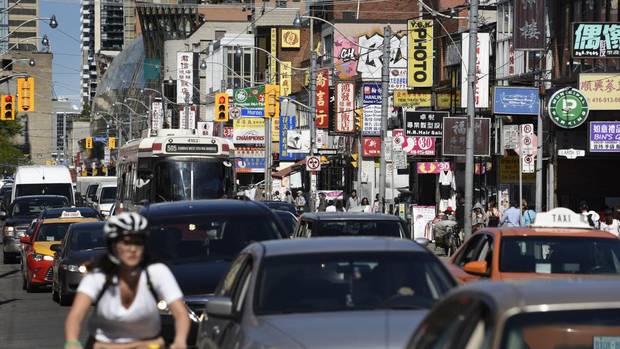
Rush hour commuters in Toronto’s Chinatown.
Fred Lum/The Globe and Mail
And the area still functions as an early landing pad for new immigrants, although they typically move out within a few years to suburban enclaves. But new ones are always arriving.
As a result, most of Mr. Yu's organization's efforts are focused on making the area more welcoming for visitors. A current project is to create a public square on Huron Street, north of Dundas Street, and decorate it with Chinese-themed furniture and public art to send a visible message about the area's culture. The group also works with local police on safety issues.
In Vancouver, though, the backlash to that potential solution for Chinatown – development to bring in new residents – is at fever pitch after a new policy appears to have opened the floodgates in a city where real estate prices are so high that developers are stampeding into the most unlikely areas.
"We had no idea that Chinatown would be so attractive to them," says Henry Tom, a director of the Chinatown Merchants Association.
Six years ago, after a series of public hearings, Vancouver city council voted for policies that a huge majority of Chinatown groups and supporters had decided, some reluctantly, was the best way to save Chinatown – a rare consensus in a community that is famous for factions that can't agree. The policy protected some sections of Chinatown as heritage areas while opening up others for buildings as high as 120 feet.
Three new condo buildings were built almost immediately under those guidelines. Then the ground shifted.
The Beedie project became the focus of a wave of angst and suspicion.
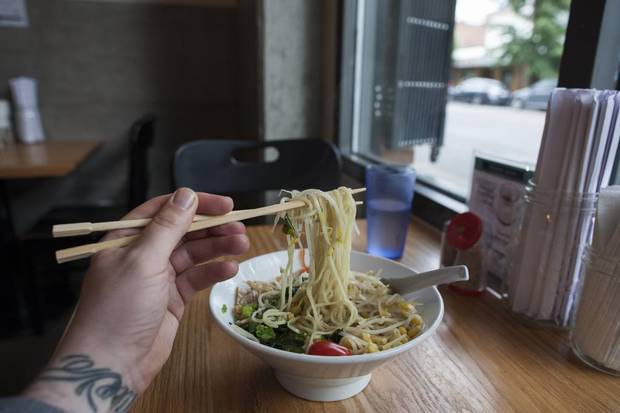
The Ramen Butcher in Vancouver’s Chinatown.
Rafal Gerszak/for the globe and mail
But underneath the debate about development are other, even more difficult questions for those trying to preserve Chinatowns.
Can they still be Chinatowns if non-Chinese people become the majority of the local population? And if most of the businesses aren't Chinese?
A busy block of Vancouver's Georgia Street, for example, still has three Chinese produce stores, a butcher, a fish store, a housewares shop, a tea shop, a herbal-medicine supplier, a doctors' office with advertising in Chinese characters, an appliance dealer and a store selling cheap clothing, some with Chinese motifs.
But it also has a "modern American restaurant … with taxidermy," hip ramen and noodle eateries with contemporary Chinese-fusion menus and an upscale coffee shop. There are also offices for an advertising company and a small art gallery.
That might look like a successful blend of old and new, but to some in the community, it's not a balance. Instead, it's the edge of a wave they fear will eventually drown traditional Chinatown. And they say condo developments – in particular projects such as the Beedie proposal – are the underlying push.
"This will further drive up speculative investment and drive out legacy businesses," said Kevin Ly, one of the young speakers at the City Hall public hearing. "If you want people to come back, market housing isn't the solution."
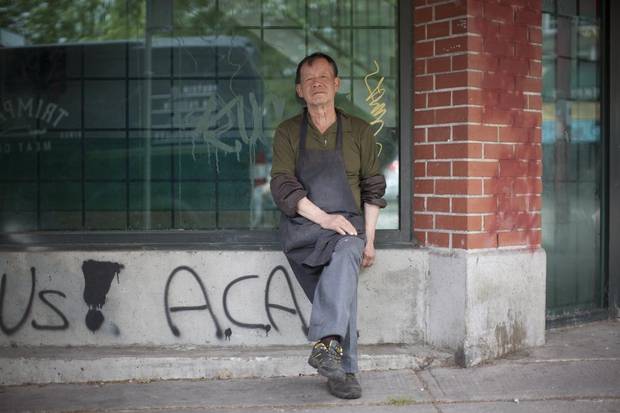
A worker from Tin Lee Market in Vancouver’s Chinatown takes a break.
Rafal Gerszak/for the globe and mail
Victor
Toh, who lives in one of the neighbourhood's newer, and larger, condo developments, said he was attracted to the area in part because he saw it as a way of reconnecting to a Chinese culture he hadn't had much exposure to when he was young.
But for Mr. Toh, who is Chinese from Malaysia and then Toronto, the real driver for the move to Chinatown was money and convenience for his family.
His wife, Medde de Vera, works as a cocktail server and relief supervisor at the city's downtown casino. Mr. Toh runs a special program in the Downtown Eastside for preteens with learning problems and special needs. The new condo means both of them can walk to work, rather than commuting from the far east side of Vancouver where they used to live.
And the price was right. The couple paid a mere $275,000 for their ninth-floor, 583-square-foot condo – an amount that now seems like chicken feed in Vancouver's hot real-estate market.
The couple, with their eight-year-old son, try to eat and shop in the area as much as possible, patronizing Kent's Kitchen or the food-court restaurants in Chinatown Plaza several times a month – to "support the little guy," as Mr. Toh puts it.
Still, he says the neighbourhood's transformation is inevitable. "I like the Chinese culture, but I don't think they're going to be able to stop change here."
MORE FROM THE GLOBE AND MAIL:
